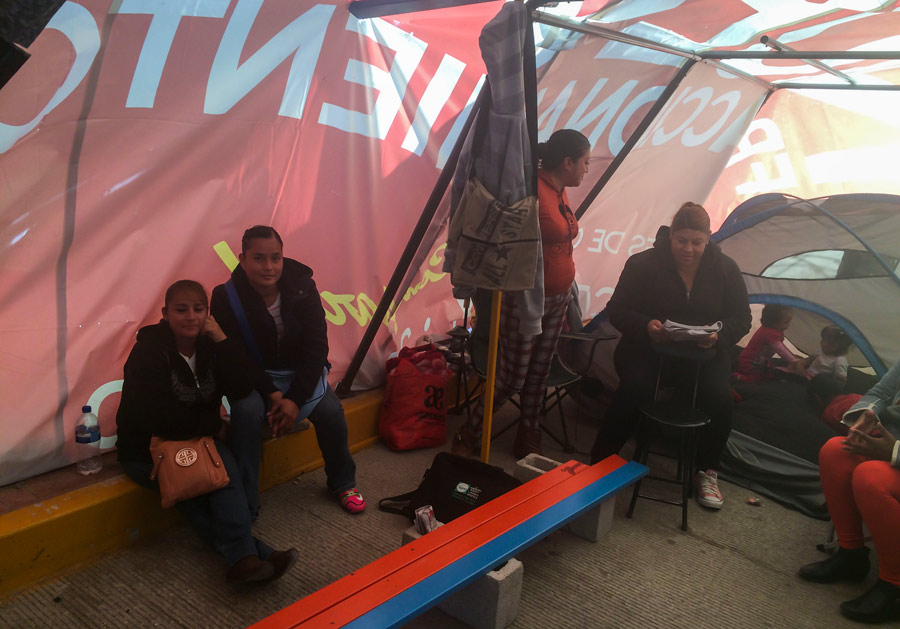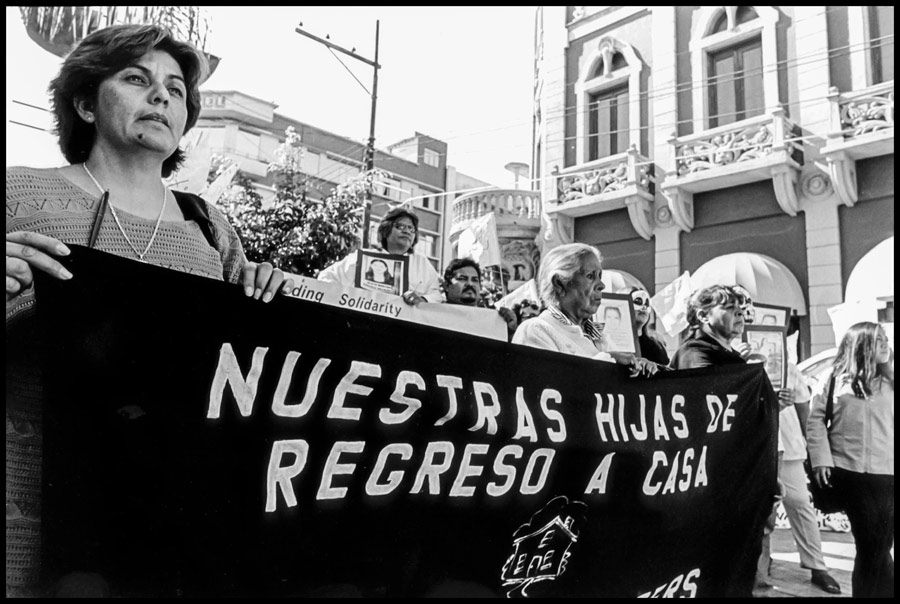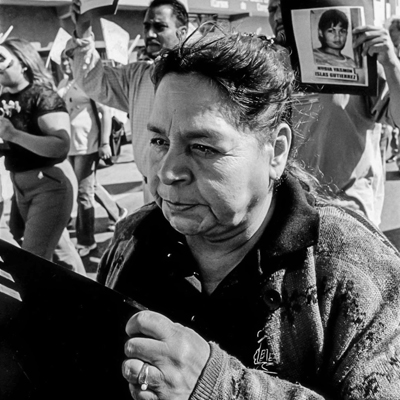The Maquiladora Workers of Juárez Find Their Voice
https://portside.org/2015-12-03/maquiladora-workers-juarez-find-their-voice

Portside Date:
Author: David Bacon
Date of source:
The Nation

Ciudad Juárez - After more than a decade of silence, maquiladora workers in Ciudad Juárez have found their voice. The city, just across the Rio Grande from El Paso, Texas, is now the center of a growing rebellion of laborers in the border factories. At the gates to four plants, including a huge 5,000-worker Foxconn complex, they have set up encampments, or plantons, demanding recognition of independent unions, and protesting firings and reprisals.
"We just got so tired of the insults, the bad treatment, and low wages that we woke up," explains Carlos Serrano, a leader of the revolt at Foxconn's Scientific Atlanta facility. "We don't really know what's going to happen now, and we're facing companies that are very powerful and have a lot of money. But what's clear is that we are going to continue. We're not going to stop."
About 255,000 people work directly in Juárez's 330 maquiladoras, about 13 percent of the total nationally, making Juárez one of the largest concentrations of manufacturing on the US/Mexico border. Almost all the plants are foreign-owned. Eight of Juárez's 17 largest factories belong to US corporations, three to Taiwanese owners, two to Europeans, and two to Mexicans. Together, they employ over 69,000 people-more than a quarter of the city's total.
Five (two of the US and all of the Taiwanese companies) are contract manufacturers of electronics equipment. They assemble, and even design, laptops, cellphones, and other electronic devices that are later sold under the famous brand names of huge corporations. One contract manufacurer, Foxconn, is the world's largest. The Taiwanese giant became notorious several years ago when workers in a huge plant in China committed suicide over stressful and abusive conditions.
Three Juárez plants produce auto parts and electronics, including the city's largest factories-Delphi, with over 16,000 workers, and Lear, with 24,000. Eleven of the top 17 maquiladoras are electronics manufacturers, whether for autos or consumers.
"In the United States people make in one hour what it takes us all day to earn." -Ali Lopez
In most other maquiladora cities like Tijuana or Matamoros, workers are rigidly controlled, and independent organizing suppressed, by a political partnership between the companies, government authorities, and unions tied to Mexico's old ruling party, the Institutional Revolutionary Party. Often when workers file papers to gain legal status for an independent union, they discover that the company has a longstanding agreement with one of the charro unions. The local labor board then places obstacles to prevent any independent organizing. This arrangement is used as a selling point, to convince foreign corporations to invest in building factories.
Juárez has been an exception, however. Its selling point has simply been that it has some of the lowest wages on the border. Manufacturing consultant Chet Frame told the El Paso Inc. website that while company-friendly unions have agreements in other border cities, "they have not been able to get a toehold in Juárez." As a result, a survey by the Hunt Institute for Global Competitiveness found that the average pay of Juárez maquiladora workers was 18 percent less than the average for manufacturing workers in Mexico's border cities.
The Juárez protests come just as Congress gets ready to debate a new trade treaty, the Trans-Pacific Partnership, which opponents charge will reproduce the same devastation Mexican workers experienced as a result of the North American Free Trade Agreement. Critics charge that NAFTA cemented into place this regime of low wages, labor violations, and violence on the border after it took effect in 1994. Today, economic pressure has become so extreme that Juárez workers feel they have no choice but to risk their jobs in hope of change.
Ali Lopez, a single mother at the planton outside the ADC CommScope factory, describes grinding poverty. "The only way a single mother can survive here is with help from family or friends," she says. Lopez has two daughters, one 13 and one 6 years old. "I can't spend any time with them because I'm always working. When I leave in the morning, I leave food for the older one to warm up for lunch. Childcare would cost 200 pesos a week or more, so I can't afford it."

The planton at CommScope in Juarez, Mexico.
Credit: Cuauhtemoc Estrada
A cold winter has already descended on Ciudad Juárez, close to freezing at night. Parents worry that children at home alone with a heater for warmth risk fire in highly flammable homes of cardboard or castoff pallets from factories. "We just have enough money to eat soup and beans," she explains. "We don't eat meat." Lopez's wage is 600 pesos a week (about $36). "No one can live on this. A fair wage would be 250 pesos a day. In the United States people make in one hour what it takes us all day to earn."
This new workers' movement began in August. At Foxconn, people started talking in the bathrooms, at lunch, and on the lines. Anger over conditions quickly started to rise. Operators on the line there make 650 pesos a week (about $39). A family with kids, according to Serrano, needs 700-800 just for food. A gallon of milk in Juárez costs the same as it does in El Paso, on the other side of the Rio Grande.
"Some foremen would tell young women that they had a good body, and demand to go out with them," Serrano adds. "If they didn't, they'd call the women lazy or burros or good for nothing. If the women went to human relations, the harassment still didn't stop." In order to survive, some women were putting in two shifts, back to back, or even working three days straight through. When they protested harassment, overtime was cut off, he says.
At CommScope, supervisors charged 50 pesos a week to put someone's name on the list for overtime, charges Cuauhtemoc Estrada, lawyer for the workers in the plantons. "They felt so humiliated that some would break into tears." According to Raul Garcia, a CommScope worker, those who protested were sent to a special work area known as "the prison," or simply, "hell." Older or slower workers were sent to another, called "the junkyard," where they were humiliated and ridiculed.
On September 16, Mexico's National Day, a group of 190 CommScope workers went to the local labor authorities, the Conciliation and Arbitration Board, and filed a request for a registro, or legal status, for an independent union. According to Garcia, the new union's general secretary, the company then started cutting overtime. Some married couples had been working different shifts, so that each could be home to take care of children. Managers reassigned them to the same shift, forcing one to quit. Finally, 171 workers were fired on October 19. The terminated workers then organized a permanent planton at the factory gates.
At Foxconn, workers asked for a registro for their own union in September. The labor board set up meetings with company managers to discuss their grievances. "The managers agreed to do small things, like reinstate the `employee of the month,'" Serrano recalls. "But on the big issues like wages and mistreatment, they just promised to do something next year."
"They're treating us like criminals, but we're workers who have been there for many years." -Carlos Serrano
Workers organized a demonstration at the gates to pressure Foxconn. When managers threatened them, the demonstration went on for a week. The company filed a civil suit for damages against its own workers, and in mid-October the firings began there also. Serrano was the first, and by the end of the month 110 people had been terminated. On November 2 they set up a planton, and have been living at the gate ever since. "They're treating us like criminals," he says, "but we're workers who have been there for many years. They have to reinstate us, and the government has to give us our registro."
Neither Foxconn nor CommScope responded to interview requests, but Rick Aspan, vice president of corporate communications for Commscope, told Frontera Norte Sur, a news site published at the Center for Latin American and Border Studies at New Mexico State University in Las Cruces, that "we terminated fewer than ten people from the facility recently," for violating company rules.
Plantons have now spread to two other maquiladoras, a Lexmark factory making ink cartridges, and an Eaton Corporation auto parts plant. By US standards, these are all huge plants. Foxconn's two factories employ more than 11,000 people. CommScope employs 3,000, and Lexmark 2,800.
Lexmark workers just filed their own request for a union registro. On November 10 the planton activists from all four companies mounted their second march through the city, demanding reinstatement and the right to an independent union. In response, the maquiladora association has begun threatening to close factories.
"The factories that are expanding won't do so in Juárez, and to begin with we'll lose 2,500 jobs," José Yarahuan Galindo, president of Export Industry-Maquiladora Association, told the local newspaper, El Mexicano. "Various companies are considering going to another city on the border, where they're treated better."
It would be hard, however, to imagine what better "treatment" the companies could find elsewhere, at least in terms of wages. In 2013, the minimum wage in Juárez was less than 65 pesos a day (today about $3.88).
At the beginning of the NAFTA era, Juárez's low-wage system was challenged by several early attempts to organize independent unions. In 1993, a partnership between the Mexican labor federation, the Authentic Labor Front (FAT), and the United Electrical Workers, a US union, mounted a campaign at the General Electric factory, Compania Armadora. Workers were fired, but pressure from UE members in US plants forced GE to rehire several of them. Nevertheless, the FAT lost the election that would have given it the right to negotiate a contract.
Other worker protests took place in the same period. At Clarostat, a division of Allen Bradley Corporation (now Rockwell Automation), workers tried unsuccessfully to organize to raise wages. When one of them, Alma Molina, was fired and then tried to get a job at a GE plant, a manager told her that her name was on a blacklist.
Worker activism of the period was fueled by a wave of birth defects. Be-tween 1988 and 1992, 163 Juárez children were born with anencephaly-without brains-an extremely rare disorder. Health critics charged that the defects were due to exposure to toxic chemicals in the factories or because of their discharges.

Rosario Acosta and other mothers march on November 10 behind the banner of the group they organized: "Nuestras Hija de Regreso a Casa"-"May Our Daughters Come Home."
Credit: David Bacon
In the mid-1990s, Mexican and US unions cooperated in opening a Center for Labor Studies (CETLAC) to help educate workers about their rights. It focused on the three factories owned by Lear Industries, which supplies car seats to General Motors. CETLAC director Guillermina Solis charged at the time that companies didn't want to hire pregnant women, and even fired women when they became pregnant in order to avoid government-mandated maternity benefits. Her allegations were supported by the Women's Rights Project of Human Rights Watch.
"When I was being hired, after the interview, they asked me when I would have my next period," one worker explained. "They said I couldn't actually start work until I had it. On the first day of my period, I came back. The nurse was there, and she said, `Let's see it, show me the sanitary napkin.' They accepted me that same day."
Worker activism of the 1990s, however, declined as the city's women became victims of a notorious series of mass murders that terrorized them for a decade. By February 2005, more than 370 women had been murdered since 1993. In 2010 alone, 247 women were murdered, and between January and August of the following year, another 130. Despite the terror, the mothers of Juárez organized to fight for the lives of their daughters. They charged that larger social forces were responsible for creating a climate of extreme violence against women.
Juárez has become a huge metropolis, built on the labor of tens of thousands of young women, overwhelmingly migrants, who have traveled north from cities, small villages, and rural areas in central and southern Mexico. "While the city and its industry depend on them totally, they are important only as productive workers, not as human beings," Rosario Acosta, mother of one of the disappeared women, explained in a 2003 interview. "We've opened the big door, our border to the US, in order to allow big multinationals to settle in our city. We give them a permit to do absolutely anything. They don't have to guarantee the most elementary aspects of life, from wages women can live on to basic service in our communities, or even just security."

Soledad Aguilar.
Credit: David Bacon
Residents of the border are treated as throwaway people, whether they're factory laborers in the plants or barrio residents living along dirt roads, in cardboard houses with no sewers, running water, or electricity. According to Julia Monarrez Fragoso, a professor at Tijuana's College of the Northern Border, "The practices of the maquiladora industry toward the workers reveal a consume-and-dispose cycle."
This new wave of worker protests, therefore, is breaking the fear and terror that has gripped working-class neighborhoods for over a decade. Elizabeth Flores has been director of the Pastoral Center for Workers, a center within the Catholic diocese of Ciudad Juárez that has advocated for the welfare of maquiladora workers for the past 15 years. According to Flores, "Each week a woman comes through our center looking for her daughter. At the same time, parents have lost hope that any better future awaits their children other than a job in the maquiladora. And young people themselves don't want to go to work there. Spend their lives-for what?"
Nevertheless, she says, "People are tired of the abuse, which has been terrible. They had to lose their fear to protest, but desperation and anger are potent antidotes to fear."
This year, the business community of Juárez is celebrating 50 years of the Border Industrial Program, which opened the door to the maquiladora boom. In that time, two and a half generations of workers have passed through the plants. "They were always the fundamental part of production," concludes Cuauhtemoc Estrada. "But the global economic model imposed on us by free trade meant the objective was always producing the most at the lowest cost. Now we see the result. And as difficult as it may be, workers are determined to change it."
[David Bacon is author of Illegal People-How Globalization Creates Migration and Criminalizes Immigrants (2008), and The Right to Stay Home (2013), both from Beacon Press.]
Copyright c 2015 The Nation. Reprinted with permission. May not be reprinted without permission. Distributed by Agence Global.
Please support our journalism. Get a digital subscription to The Nation for just $9.50!
